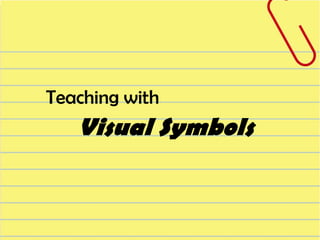
Educational technology
- 2. Visual symbols -Representations of direct reality, which comes in the form of signs and symbols.The visual aids are what help the students understand what the lesson is all about. -There are different kinds of visual symbols. These include drawings, cartoons, strip drawings, diagrams, charts, graphs and maps.
- 4. A. DRAWINGS - Concrete visual or a representation of a real thing. It helps illustrating our lecture through freehand sketching in a chalkboard.
- 5. Samples
- 6. B.CARTOONS - Another kind of visual symbol. It tells its story metaphorically. The perfect cartoon needs no caption. The symbolism conveys the message. -It could also be used as a springboard for a lesson or a concluding activity.
- 7. SAMPLES
- 8. C. STRIP DRAWINGS -commonly called comics or comic strip. It is educational and entertaining at the same time. - it could also serve as motivation and a starter of a lesson. It can also be given as an activity for students to express insights gained at he conclusion of a lesson.
- 10. D. DIAGRAMS- Any line drawing that shows arrangement and relations as of parts to the whole, relative values, origins and development, chronological fluctuations, distributions, etc. –DALE The word GRAPH is sometimes used as a synonym for diagram.
- 11. Types of a Diagram
- 12. •Affinity Diagram - used to cluster complex apparently unrelated data into natural and meaningful groups. - is a tool that gathers large amounts of language data (ideas, opinions, issues) and organizes them into groupings based on their natural relationships .
- 14. Tree Diagram - Used to chart out, in increasing details, the various tasks that must be accomplished to complete a project or achieve a specific objective.
- 16. Fishbone Diagram - Also called cause-and-effect diagram. It is a structured form of brainstorming that graphically shows the relationship of possible causes and sub causes directly related to an identified effect/problem. It is most commonly used to analyze work-related problems.
- 18. E. CHARTS - diagrammatic representation of relationships within an organizations. • Time Chart • Tree or Stream Chart • Flow Chart • Organizational Chart • Comparison and Contrast Chart • Pareto Chart
- 19. Time Chart - tabular time chart that presents data in ordinal sequence.
- 21. Tree or Stream Chart -depicts development, growth and change by beginning with a simple course with spread outs into many branches.
- 23. Flowchart - visual way of charting or showing a process from beginning to end. It is a means of analyzing a process. By outlining every step in a process, you can begin to find inefficiencies or problems.
- 25. Organizational Chart - shows how one part of the organization relates to other parts of the organization.
- 27. Comparison and Contrast Chart A compare and contrast chart used to evaluate the similarities and differences between two subject or objects.
- 29. Pareto chart - type of bar chart, prioritized in descending order of magnitude or importance from left to right.
- 31. F. GRAPHS - pictures that help us understand amounts. These amounts are called data.
- 32. Circle Graph - is shaped like a circle. It is divided into fractions that look like pieces of pie, so sometimes a circle graph is called a pie graph. Many times the fractional parts are different colors and a key explains the colors.
- 34. Bar Graph - uses bars to show data. The bars can be vertical (up and down), or horizontal (across). The data can be in words or numbers.
- 36. A Picture Graph- uses pictures or symbols to show data. One picture often stands for more than one vote so a key is necessary to understand the symbols.
- 38. GRAPHIC ORGANIZER -you met several graphic organizers in your subject, principles of teaching.
- 39. Samples
- 40. Map/Maps -Maps represent the surface of the earth. Different kinds of maps can be used depending on what the lesson is about.
- 41. Kinds of Map •RELIEF MAP •PHYSICAL MAP •COMMERCIAL or ECONOMIC MAP •POLITICAL MAP
- 42. RELIEF MAP has three dimensional representations and show contours of the physical data of the earth or part of the earth.
- 44. PHYSICAL MAP combine in a single projection data like altitude, temperature, rainfall, pre cipitation, vegetation and soil.
- 46. COMMERCIAL or ECONOMIC MAP Also called product or industrial map since they show land areas in relation to the economy.
- 48. POLITICAL MAP Gives detailed information about country, provinces, cities and towns, roads and highway. Oceans, rivers and lakes are themain features of most political maps.
- 50. MAP LANGUAGE • SCALE- shows how much of the actual earth’s surface is represented by a given measurement on a map. The scale must be shown so thet the map reader can use the distances and areas shown on the map. 1 inch = 15 statute miles SYMBOLS- usually a map has a legend that explains what each symbol means. Some symbols represent
- 51. • COLOR- the different colors of the map are part of the map language. GEOGRAPHIC GRIDS- the entire system of these grid lines are called grid lines. These grid lines are called mrridians and parallels. • Meridian-north to south pole line. • Parallels- lines drawn around a globe with allpoints. • Longitude- distance in degrees of any place east or west of the prime meridian. • Latitude- distance in degrees of any place north and south of the equator.
- 52. Submitted by: Ricalyn T. Obal Student Submitted to: Mary Gene I. Panes Professor
